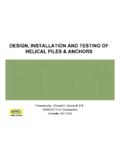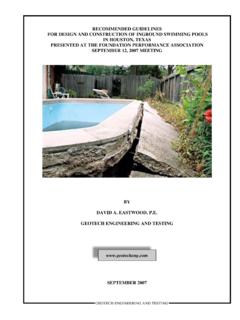Transcription of INTRODUCTION TO GEOPIER SYSTEM - FPA
1 INTRODUCTION TOGEOPIER SYSTEMMr. Gerry Kehler, PE (Georgia)Mr. Tommy WilliamsonApril 14, 2010 OUTLINE1. History of Foundation Support2. GEOPIER SYSTEM Construction3. Engineering Basics4. Different soil types5. Limitations6. Industrial Applications7. Case studyTwo choices:History of foundation systems1. Shallow 2. DeepGood soilBadsoilGood soilOK soilIn early 1990 s a third choice emerged:Intermediate Foundation systems1. Shallow 2. Deep 3. IntermediateGood soilsOK soilBadsoilGood soilOK soilHistory of foundation systemsThe GEOPIER Systems are made up of Rammed Aggregate Pier elements. With time, the GEOPIER SYSTEM gained popularity with cost and schedule of foundation systems1. Created by forming a cavityRammed Aggregate Pier Construction2. Adding thin lifts of Aggregate, andRammed Aggregate Pier Construction3. Vertically RAMMING the thin lifts of aggregateRammed Aggregate Pier ConstructionRammed Aggregate Pier ConstructionTemporary casing used to stabilize caving soils Rammed Aggregate Pier ConstructionDisplacement ConstructionDisplacement ConstructionThen, as hollow mandrel is raised, stone flows from hopper down through hammerAfter driven to full depth, mandrel is raised up 3 ftThen driven back down 2 ftDense, 1 ft liftsCrowd pressure from rig weight and hydraulicsFirst, mandrel is driven to full depth, with sacrificial cap covering tamper Construction E xcavate for footings Compact footing bed Place steel Pour concreteTypes of Foundations Supported Isolated Spread footings Continuous footings Retaining Walls Lightly loaded slabs Heavily loaded slabs Uplift AnchorsFlexible Continuous FootingsThe keys to success are:1.
2 Vertical RAMMING (to achieve very low void ratio) and 2. Increase in lateral effective stress from the beveled tamper footGeopier SYSTEM FeaturesBeveled tamperGeopier SYSTEM Features H igh allowable bearing capacity Control settlement Uplift resistance Lateral load resistanceHow do RAP systems work?Engineering basicsPush down on footing, the stiff element (pier) takes more of the loadHow do RAP systems work?The strength and stiffness of the pier determined using a Modulus Test which gives you a spring constantEngineering basics Deflection = kg= stress / deflection = 500 deflectionRAP Stress (ksf)Deflection (in)Telltale deflectionDesign(a)(b)Uplift anchors required to resist tensile loadsSteel PlateCylindrical shearingsurfaceThreaded rodsUplift ResistanceLoad Test Uplift Element at UC DavisProduction Uplift ElementsUplift ResistanceLateral ResistanceRAP and Soil Types S and, silty/clayey sand, gravel (SP, SW, SM, SC, GW, GP) Clays and silts(CL, ML) Peats and organics(PT, OL) Undocumented fillGEOPIER LIMITATIONS E xtreme loads on extremely soft soils Sinkholes Expansive / swelling clay Obstructions during drillingEconomics:Often provide a 20% to 40% cost savings in comparison with Deep Foundations when.
3 High capacity > 75 tons and length > 30 feet Moderate capacity > 40 to 60 tons and length > 20 feet Low capacity < 40 tons and any lengthPile lengthPile capacityRAP provides MORE economyRAP provides LESS economyWhen To Consider RAP SystemsEconomics:Often provide a 20% to 40% cost savings in comparison with over-excavation and replacement when: The depth of overexcavation exceeds 5 -8 To Consider RAP SystemsGeopier SystemApplicationsBuilding Foundation SupportIndustrial & Tank SupportFloor Slab SupportTransportation Five story parking deck 63,000 sffootprint 77 columns with loads ranging from 200 to 1220 kips Foundation options for RAPs and auger cast pilesCASE STUDYVICTORYLAND PARKING DECKSHORTER, ALABAMASUBSURFACE PROFILELOWER ZONE1220 ,000 10,000 15,000 20,000 25,000 30,000 Applied GEOPIER Stress (psf)Deflection (inches)Bottom of GeopierTop of GeopierUnloadModulus test resultsVICTORYLAND PARKING DECKM easured Upper Zone Settlement = Estimated Lower Zone Settlement = Total Settlement = 530 RAP elements installed in 11 days!
4 VICTORYLAND PARKING DECKE lements reinforce soft and compressible soils for support of relatively thin floor structural floor slabs on SLAB SUPPORTD esign ConsiderationsFLOOR SLAB SUPPORTG eotechnical (settlement, etc)Structural (slab design, etc)FLOOR SLABS -GEOTECHNICALFill and floor slab supportdspacing (s)"competent" soilsSoft, compressible soilsFloor load (p)New Fill45oThicknessRAP element(t)Arching transfers pressures to pierFLOOR SLABS STRUCTURAL Steel Reinforcement.. May be required to resist tensile stresses within top of slaboverlying GEOPIER elements. Need to:-W ork closely with structural engineer-Perform finite element analysis (project SE or GFC SE)Results of analysis identify areas of higher bending stressesIndicate whether added reinforcement or thicker slab is neededFinite Element Analysis (FEA)FLOOR SLABS STRUCTURAL FLOOR SLAB SUPPORTB oeing Building 101, St. Louis, MODelta Marine, Seattle, WACostco Retail Store, Tacoma, WAPolaris Plant, Vermillion, SDKRAFT CAPRI-SUN WAREHOUSE GRANITE CITY, ILLINOISK raft Capri-Sun WarehouseGranite City, IllinoisSt.
5 Louis, MOFLOOR SLABS -EXAMPLE Floor Slab700 psf pressure5 ft fill to get out of floodplainFLOOR SLABS -EXAMPLE 10ftCH & CL, Su = 500 psf0 10 2030 40SP, SMN-values, M%Subsurface conditionsFLOOR SLABS -EXAMPLE Soft Clay Dense Sand and Silty SandSoft ClayFloor Slab Winter construction GroundwaterFillPlanned construction10 ftFLOOR SLABS -EXAMPLE OPTIONS?Rammed Aggregate Pier stabilized zoneFloor SlabDense Sands and Silty SandsValue engineering proposalPier spacing = 14 ftFLOOR SLABS -EXAMPLE 4000 8000 12000 16000 20000 24000 28000top of Geopiermiddle telltalebottom telltaleGeopier Stress (psf)Deflection (in)15 Modulus testFLOOR SLABS -EXAMPLE MonitoringSettlement (in)Time (days)Pier = in ( )Soil = in ( )Differential = in (0 in)Differential settlementFLOOR SLABS -EXAMPLE FLOOR SLAB SUPPORT 360,000 sq. ft. manufacturing facility addition Floor slab pressures = 700 psf 2,100 Geopierelements installed in one monthMirant Power Plants, MD POWER GENERATIONM organtown Plant Mat foundation:91-ft x 357-ftAbsorber stacks and buildingDesign pressures:3 ksf at building6 ksf at stacksNanjemoyFormation (N > 30)ML (N = 8 20 bpf)SM (N = 3 15 bpf)14 Excavation18 ~26 Impact RAPs:4 to 6 ft o-cEst.
6 Settlements:~ inchesChalk Point Plant Mat foundation:87-ft x 219-ftAbsorber stacks and buildingDesign pressures:3 ksf at building6 ksf at stacksImpact RAPs:4 to 6 ft o-cEst. settlement:~ inchesNanjemoyFormation (N > 30)MH (N = 11 26 bpf)SM (N = 5 11 bpf)17 40 ~26 ExcavationTANK SUPPORTB earing CapacityUnsuitable SoilCompetent SoilDESIGN ISSUESDESIGN ISSUESS ettlementUnsuitable SoilCompetent SoilDESIGN OPTIONSO verexcavationand ReplacementProblems High groundwater Cost ScheduleDESIGN OPTIONSPile-supported concrete padProblems Cost ScheduleDESIGN OPTIONSG ranular pad over Geopierreinforced zone GeopierReinforcement ZoneSAMPLE INDUSTRIAL PROJECTS H ouston Fuel Oil Terminal Tank Support Kinder Morgan Tank 150-27 Repair Valero Refinery Tank TK-443 Lyondell-CitgoTank Repair Kinder Morgan Tank 150-44 Valero Refinery Tank TK-231 Industrial ZeolitePlant ExxonMobil Tank 2176 Repair ConocoPhillips Refinery New tank construction 125-foot diameter 48-ft tall Design pressure = 3 ksfCASE HISTORY:VALERO REFINERY TANK TK-231 HOUSTON, TX4ftSu (ksf) Fill0ftSUBSURFACE Soft to Firm ClayFirm to V.
7 Stiff Clay10ftGEOPIER SOLUTIONP erimeter Differential Settlement ControlFillSoft ClayFirm to V. Stiff ClayGEOPIER SOLUTIONB earing Capacity Edge Instability V. Soft to Firm ClayFirm to V. Stiff ClayGeopierFS for GEOPIER -reinforced soil = Load Test of GeopierTelltale No. 1 Top of GEOPIER Stress (ksf)Deflection (in)Design StressDeflectionGEOPIER SOLUTIONS ettlement = in at design stress Installed 243 piers in 8 days (30 piers / day) Increased edge stability (FS = ) Limited perimeter differential settlements GEOPIER SOLUTION Duke Energy Ameren (UE) Motiva Lockheed ExxonMobil Valero Nucor Steel General Motors BNSF Kinder Morgan Boeing Food ServicesSelected National Clients C ertainteed Kraft John Deere Case New Holland Pfizer Wal-Mart Michelin Maybelline Pacific Bell Sara Lee Anheuser Busch General MillsShear reinforcement inGeopier zoneTRANSPORTATION APPLICATIONSUS-90 & SH-6 Intersection Upgrades, Sugarland, TexasSite PlanSCOPE OF WORK / 22107 / 353 South / / 353 North / 2769 / 227 South / 2479 / 260 North AbutmentMax.
8 Height(m)/ [ft]Length(m)/[ft]MSE Wall LocationTypical Soil Conditions02468101214160 10 20 30 40 50 60 70 w%Depth (m)GWTCL SMSM, SW ' = 22 c' = kPa ' = 30 c' = 0c c = - r = - ' = 30 c' = 00 10 20 30 40 50 60 70 80 90 North RampSouth RampNorth AbutmentSouth AbutmentSu (kPa)CL SMGeopier Installation Total Number of Piers = 1411 Two Crews 20 to 25 RAPs Cost ~ $1,000,000 Bid Through DOT letting FHWA funded the geotechnical instrumentationModulus Test Results-60-55-50-45-40-35-30-25-20-15-10 -50030060090012001500 Top-of-Rammed Aggregate Pier Stress (kPa)deflection, (mm)North AbutmentSouth AbutmentSouth RampSouth Ramp IINorth RampDesign Stress < 18000 psf< -in top vertical deflectionGeotechnical Instrumentation LayoutNear the bridge Abutments at general locations of higher bearing pressureMonitoringStation 1 MonitoringStation 2 EastWestGeotechnical InstrumentationHorizontal and Vertical InclinometersVibrating Wire PiezometersSondex Settlement SystemInstrumentation InstallationVibrating Piezometer CableHorizontal InclinometerCasing w/Cable ReturnProtectiveInstrumentationBoxInstru mentation Monitoring ResultsHorizontal and Vertical InclinometersPiezometer NestSouth Ramp Monitoring Station-10481216202411/29/0512/27/051/24 /062/21/063/21/064/18/065/16/066/13/067/ 11/068/8/069/5/0610/3/0610/31/0611/28/06 12/26/06 DatePore Pressure (psi)024681012 Fill Pressure (psi)
9 -15 ft-20 ft-24 ft-30 ftFillSpike Caused by Driving of Pile within 5 ft of PiezometersGradual Rise in Pore Pressure Caused by General Rise in Groundwater ElevationInstrumentation Monitoring ResultsSondex Settlement SYSTEM -South (ft)Downward Movement (ft)1/27/20061/25/20061/26/20062/1/20062 /9/20062/20/20062/23/20063/2/20063/9/200 64/6/20065/4/20067/12/20069/19/200610/24 ( )Instrumentation Monitoring ResultsVertical Inclinometers at North Ramp Movement (in)Depth (ft)North Ramp Sta. 2 - EastNorth Ramp Sta. 1-East11/2006 through 5/2007 Bottom of Retaining Wall Footing ABUTMENTNORTH RAMPSOUTH ABUTMENTSOUTH RAMPC onclusions-Vertical Settlement to 3-inches -Horizontal Displacement < Pore Water Pressure Dissipation Afforded by Radial Drainage into RAPs-Vertical Displacement < 2-inchesPost-Construction-Complied with FHWA requirementsQuestions?






